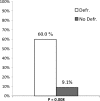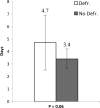Clinical outcome of ablation for long-standing persistent atrial fibrillation with or without defragmentation
- PMID: 24155102
- PMCID: PMC3890005
- DOI: 10.1007/s12471-013-0483-y
Clinical outcome of ablation for long-standing persistent atrial fibrillation with or without defragmentation
Abstract
Objective: To assess the outcome and associated risks of atrial defragmentation for the treatment of long-standing persistent atrial fibrillation (LSP-AF).
Methods: Thirty-seven consecutive patients (60.4 ± 7.3 years; 28 male) suffering from LSP-AF who underwent pulmonary vein isolation (PVI) and linear ablation were compared. All patients were treated with the Stereotaxis magnetic navigation system (MNS). Two groups were distinguished: patients with (n = 20) and without (n = 17) defragmentation. The primary endpoint of the study was freedom of AF after 12 months. Secondary endpoints were AF termination, procedure time, fluoroscopy time and procedural complications. Complications were divided into two groups: major (infarction, stroke, major bleeding and tamponade) and minor (fever, pericarditis and inguinal haematoma).
Results: No difference was seen in freedom of AF between the defragmentation and the non-defragmentation group (56.2 % vs. 40.0 %, P = 0.344). Procedure times in the defragmentation group were longer; no differences in fluoroscopy times were observed. No major complications occurred. A higher number of minor complications occurred in the defragmentation group (45.0 % vs. 5.9 %, P = 0.009). Mean hospital stay was comparable (4.7 ± 2.2 vs. 3.4 ± 0.8 days, P = 0.06).
Conclusion: Our study suggests that complete defragmentation using MNS is associated with a higher number of minor complications and longer procedure times and thus compromises efficiency without improving efficacy.
Figures



Similar articles
-
Five-year follow-up outcome after catheter ablation of persistent atrial fibrillation using a sequential biatrial linear defragmentation approach: What does atrial fibrillation termination during the procedure imply?Heart Rhythm. 2017 Jan;14(1):34-40. doi: 10.1016/j.hrthm.2016.08.041. Epub 2016 Aug 30. Heart Rhythm. 2017. PMID: 27590435
-
Remote-controlled magnetic pulmonary vein isolation using a new three-dimensional non-fluoroscopic navigation system: a single-centre prospective study.Arch Cardiovasc Dis. 2013 Aug-Sep;106(8-9):423-32. doi: 10.1016/j.acvd.2013.04.008. Epub 2013 Jul 29. Arch Cardiovasc Dis. 2013. PMID: 23906679
-
Impact of biatrial defragmentation in patients with paroxysmal atrial fibrillation: results from a randomized prospective study.Heart Rhythm. 2014 Sep;11(9):1536-42. doi: 10.1016/j.hrthm.2014.06.002. Epub 2014 Jun 4. Heart Rhythm. 2014. PMID: 24907643 Clinical Trial.
-
Pulmonary vein isolation cryoablation for patients with persistent and long-standing persistent atrial fibrillation: Clinical outcomes from the real-world multicenter observational project.Heart Rhythm. 2018 Mar;15(3):363-368. doi: 10.1016/j.hrthm.2017.10.038. Epub 2017 Oct 26. Heart Rhythm. 2018. PMID: 29107190
-
Pulmonary Vein Isolation Versus Defragmentation: The CHASE-AF Clinical Trial.J Am Coll Cardiol. 2015 Dec 22;66(24):2743-2752. doi: 10.1016/j.jacc.2015.09.088. J Am Coll Cardiol. 2015. PMID: 26700836 Clinical Trial.
Cited by
-
Ablation of "Background Tachycardia" in Long Standing Atrial Fibrillation: Improving the Outcomes by Unmasking a Residual Atrial Fibrillation Perpetuator.J Atr Fibrillation. 2017 Aug 31;10(2):1583. doi: 10.4022/jafib.1583. eCollection 2017 Aug-Sep. J Atr Fibrillation. 2017. PMID: 29250230 Free PMC article.
-
Impact of catheter ablation with remote magnetic navigation on procedural outcomes in patients with persistent and long-standing persistent atrial fibrillation.J Interv Card Electrophysiol. 2015 Nov;44(2):197-204. doi: 10.1007/s10840-015-0037-x. Epub 2015 Jul 28. J Interv Card Electrophysiol. 2015. PMID: 26216480 Clinical Trial.
-
The symbiosis of contact force catheter use for hybrid ablation for atrial fibrillation.Neth Heart J. 2015 Aug;23(9):438-46. doi: 10.1007/s12471-015-0729-y. Neth Heart J. 2015. PMID: 26153267 Free PMC article.
-
Remote magnetic navigation vs. manual navigation for ablation of ventricular tachycardia: a meta-analysis.Neth Heart J. 2015 Sep;23(10):485-490. doi: 10.1007/s12471-015-0734-1. Neth Heart J. 2015. PMID: 26215291 Free PMC article.
-
Defragmentation in ablative AF treatment: is our knowledge too fragmented?Neth Heart J. 2014 Jan;22(1):28-9. doi: 10.1007/s12471-013-0494-8. Neth Heart J. 2014. PMID: 24259194 Free PMC article. No abstract available.
References
LinkOut - more resources
Full Text Sources
Other Literature Sources

